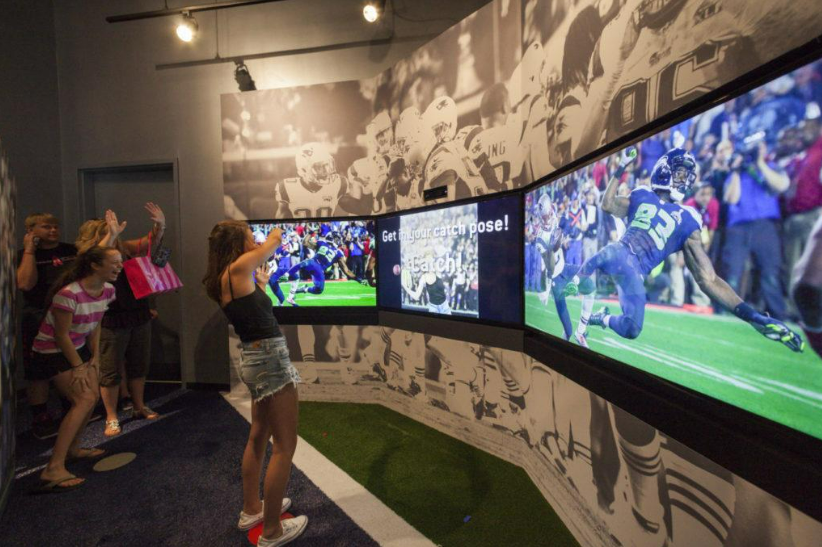In recent years, advancements in technology have become increasingly essential to visitor experiences and museum operations around the world. From providing immersive digital engagements, curating the visitor journey, improving wayfinding, and streamlining operations, technology has diverse and growing applications in the museum ecosystem. Now, more than ever, it is imperative that museums stay up to date on the latest trends in technology. CambridgeSeven’s diverse portfolio of cultural projects, ranging from Science and Sports Heritage Museums, to our continued expertise in Aquarium design, has provided us keen insights into the latest technologies being integrated in the museum environment. Here’s the “top-ten” list of technologies that we are integrating into our projects:
1) Personalization / Wearable Devices: Utilizing RFID badges, bracelets or cards worn on the body to activate chips and other technologies, we create a more powerful connection between the visitor and the story. Providing a personal link deepens the visitor’s understanding and connects them at a more resonant level with the narrative content. For example, the RFID approach makes creating a personalized scavenger hunt possible. We are currently developing just such an interactive at the Broad DNAtrium Museum where visitors use their “lab card” and participate in the scientific discoveries that led to the advancements in understanding inheritance and genetics.
2) Augmented Reality / Virtual Reality: Imagine being surrounded by your favorite hockey team while standing on center ice or seeing yourself in a science laboratory side by side with Watson and Crick building a double helix model. With Augmented Reality, museums can superimpose their virtual world right over what is actually in front of visitors, bringing exhibits and artifacts to life in new and immersive ways.
3) Gesture Technology / Non-touch Interactives: Given the present COVID-19 crisis and the heightened concern of infection risk, touchless technologies and proximity sensors like Gesturetek, Kinect and radarTouch, as well as other technologies, will likely gain popularity. These technologies are becoming less expensive and also increasing their sensitivity and accuracy which will result in more exciting visitor engagement.
4) Mobile Technologies: Mobile apps for museums are not new, but now museums are exploring ways to expand and integrate mobile technologies for a more customized experience. For example, using mobile phone technology, a museum can offer immersive guided tours and an AR experience that enriches the exhibit content. And mobile ticketing technology streamlines the process, minimizes queuing and offers touchless payment options.
5) Indoor GPS tracking systems: Museums use this increasingly affordable technology to track movement within the facility, which allows them to confirm how well a storyline works, better understand dwell time or even if the experience should be modified to help clarify the message.
6) Artificial Intelligence: When it comes to museums, AI can be incorporated across the spectrum, from visitor experience to behind the scenes, and the technology can come in many forms. Current AI use for operations includes visitation forecasting and understanding collections by using machine vision to help recognize, classify, or pattern images. On the public side, AI offers many unique opportunities to engage visitors. In 2018 the world was introduced to Pepper, a humanoid robot developed by the Smithsonian. Pepper answers visitors’ questions and tells stories using voice, gestures, and an interactive touch screen. Visitors love to interact with Pepper and the bot will even pose for selfies! AI also offers visitors the potential to interact with historical figures.
7) LED / Laser Projection Technologies: We continue to explore and push the boundaries of how advanced lighting technology and laser projection can create powerful, immersive museum environments. Using large-scale tensile fabric screening, coupled with unique media laser projections, we immerse the visitor in a story that captures the imagination.
8) Virtual Touring:We are starting to see that the future for museums and attractions may well need to allow for expanded non-physical, off-site experiences. To that end, utilizing in-house technologies and creating exhibit designs geared toward virtual touring that can account for at-home technology interfaces should be an integral part of the new museum design development from the conceptual level through project completion.
9) Flexible Technology Exhibit Platforms: With our media partners, we are developing software and designing exhibits that can not only accommodate content flexibility but also allow exhibits to easily change. Newer technologies allow us to convert exhibit curriculum into entirely new programs for focus groups, education, research and special events. Utilizing remote program technology offers museums and attractions the ability to be more flexible and responsive to new and varied audiences.
10) Augmented Reality Selfie-Moments: With Social Media now the largest platform for human communication and connection, the “Instagram” moment has become a “must have” during the exhibit journey. With advancements in digital projection technology more frequently incorporated into museum exhibits, personalizing the visit has become more common. Now, what had been primarily an analogue experience is shifting into the digital realm allowing virtual “try-ons” where visitors can place themselves in an historic exhibit virtually or even insert themselves in an historic video moment. In all aspects, this technology is expanding the variety of opportunities in which visitors can engage and share in a museum’s brand and mission.
Source: Gazaille, C. (2020, June 24). The Future of Technology in Museums. CambridgeSeven. https://www.cambridgeseven.com/about/news/the-future-of-technology-in-museums/


